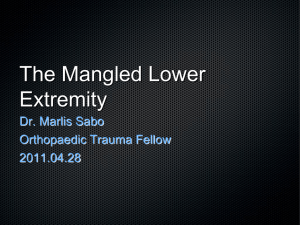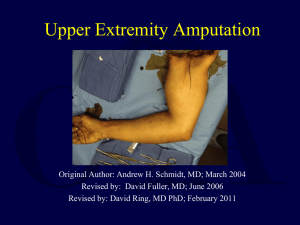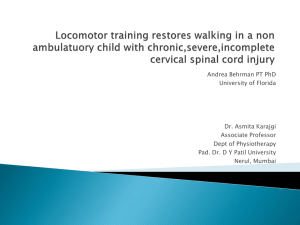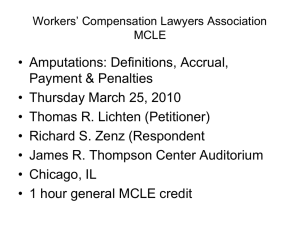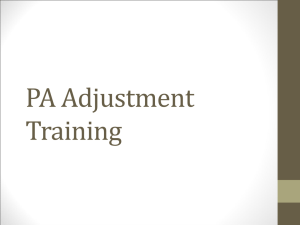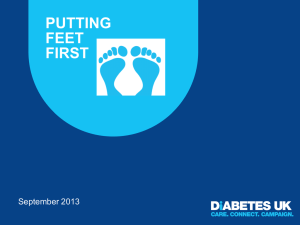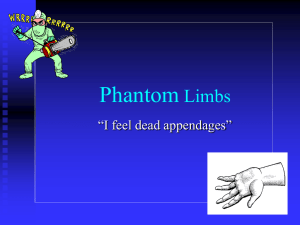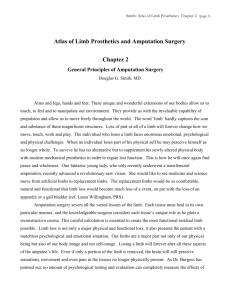conference_presentation_mh2
advertisement
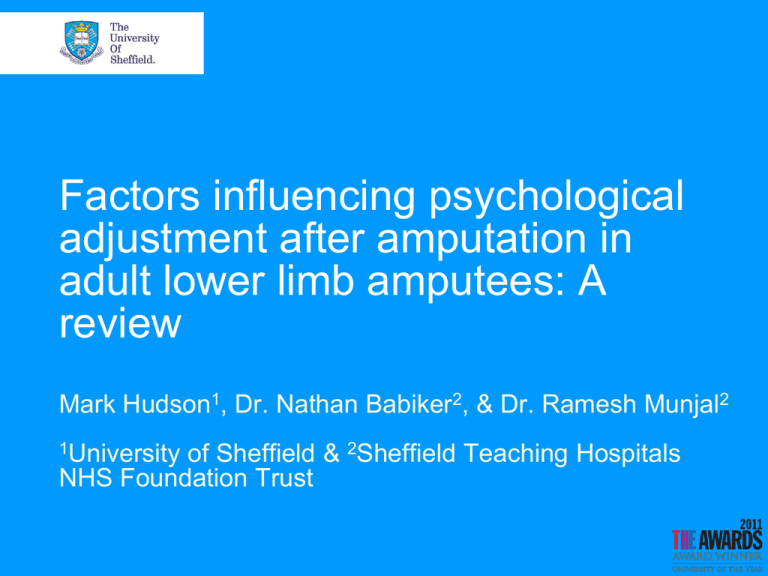
Factors influencing psychological adjustment after amputation in adult lower limb amputees: A review Mark Hudson1, Dr. Nathan Babiker2, & Dr. Ramesh Munjal2 1University of Sheffield & 2Sheffield Teaching Hospitals NHS Foundation Trust Contents 1. Background literature 2. Design of the present review 3. Results 4. Clinical and research implications 08/04/2015 © The University of Sheffield Background literature. Definition • Psychological adjustment to chronic disease involves at least five key domains: 1. Cognitive 2. Emotional 3. Interpersonal 4. Functional 5. Disease-related (Stanton, Revenson, & Tennen, 2007). Horgan & MacLachlan (2004) • Factors linked to better adjustment: • Perceived sense of control • Social support • Positive meaning • Time since amputation • Cause (trauma or disease) had no relationship. Horgan & MacLachlan (2004) • Factors linked to poorer adjustment: • Body image anxiety • Social discomfort • Pain catastrophising • Phantom limb pain • Women and younger people in a sub-set. • B/K amputees more depressed in one study. 08/04/2015 © The University of Sheffield Current review: Design. Rationale • Horgan & MacLachlan (2004) called for more qualitative and longitudinal research, and broader focus on QoL. • Significant number of studies published since the last review. • Increasing awareness of psychological risk factors in the MDT. • Increase own understanding to assist with treatment planning. Search strategy • The Psychinfo and Web of Science databases were searched, from 2004 up until February 2013. The following keyword search strategies were combined: • “psychological” or “psychosocial” • “adjustment” or “adaptation” • “amputation*” or “amputee*” Selection criteria • Population: adults with a lower limb amputation • Measures: At least one amputation-related, sociodemographic, or psychological predictor variable. A validated criterion measure of psychological adjustment. • Analysis: at least one statistical test examining the link between the predictor variables and criterion measures. • Article type: English language articles in peerreviewed journals. Paper retrieval Results. Factors linked to better adjustment • Greater levels of hope (Unwin, Kacperek, & Clarke, 2009) • Positive cognitive processing (Phelps, Williams, Raichle, Turner, & Ehde, 2008) • Increased problem solving ability (Desmond & MacLachlan, 2006a). • Having a positive appraisal of the amputation (Couture, Desrosiers, & Caron, 2011) Factors linked to better adjustment • Less phantom limb pain (Desmond et al. 2008; Whyte & Carroll, 2004) • Social support (Williams et al., 2004; Unwin et al., 2009; Hanley et al., 2004; Desmond & MacLachlan, 2006a; Hawemdah et al., 2008; Jenkins et al., 2008; Nunes et al., 2012; Singh et al., 2007) • Below-knee amputation in sub-set (Desmond & Maclachlan, 2006a; Couture et al., 2011). • Number of co-morbidties (Nunes et al., 2012; Singh et al., 2007; 2009) Factors linked to worse adjustment • Negative cognitive processing (Phelps et al., 2008) • • • • • Avoidance (Desmond & MacLachlan, 2006a) Pain catastrophising (Whyte & Carrol, 2004; Hanley et al., 2004) Public self-consciousness (Atherton & Robertson, 2006) Body-image disturbance (Coffey et al., 2009) Younger people (Gunawardena et al., 2007; Singh et al., 2009; Desmond & MacLachlan, 2006a ) • Female gender (Nunes et al., 2012) Mixed Findings • Time since amputation • Recent amputation more distressing (Desmond et al., 2006a; Nunes et al., 2012) • Recent amputation less distressing (Singh, 2007; 2009) • Cause of amputation • Disease related (Coffey et al., 2009; Desmond & Maclachlan, 2006a; Couture et al., 2011) • Trauma related (Hawemdah et al., 2008; Kratz et al., 2010) Common methodological issues • • • • • • Causality cannot be inferred Self-report bias Small sample sizes Selection bias Lack of control groups Variability in measurement tools Clinical and research implications. Clinical implications • Highlights those at risk of poor adjustment. • Indicates models of coping and resilience (Lazarus & Folkman; 1984; Yates & Masten, 2004) • Suggests therapy targets: • Changing meaning • Developing acceptance or active coping style • Social support. Research implications • Few studies on residual limb pain. • Pre-operative, longitudinal designs, with appropriate control groups needed. • Effect of ADM or alcohol/drug use. • Effect of repeated infections. Critique • Search limited to two databases • No hand-searching of journals • Grey literature not consulted • Written by one author • Experts were not consulted References Atherton, R. & Robertson, N. (2006). Psychological adjustment to lower limb amputation amongst prosthesis users. Disability and Rehabilitation, 28, 1201-1209 Coffey, L., Gallagher, P., Horgan, O., Desmond, D. & Maclachlan, M. (2009). Psychosocial adjustment to diabetes-related lower limb amputation. Diabetic Medicine, 26, 1063-1067. Couture, M., Desrosiers, J., & Caron, C. D. (2011). Cognitive appraisal and perceived benefits of dysvascular lower limb amputation: A longitudinal study. Archives of Gerontology and Geriatrics, 52, 5-11. Desmond, D. M. & MacLachlan, M. (2006a). Coping strategies as predictors of psychosocial adaptation in a sample of elderly veterans with acquired lower limb amputations. Social Science & Medicine, 62, 208-216. Desmond, D., Gallagher, P., Henderson-Slater, D., & Chatfield, R. (2008). Pain and psychosocial adjustment to lower limb amputation amongst prosthesis users. Prosthetics and Orthotics International, 32, 244-252. Gunawardena, N., De A Senevirathne, R. & Athauda, T. (2007). Mental health outcome of unilateral lower limb amputee soldiers in two districts of Sri Lanka. International Journal of Social Psychiatry, 53, 135-147. References Hanley, M. A., Jensen, M. P., Ehde, D. M., Hoffman, A. J., Patterson, D. R., & Robinson, L. R. (2004). Psychosocial predictors of long-term adjustment to lower-limb amputation and phantom limb pain. Disability and Rehabilitation, 26, 882-893. Hawemdeh, Z. M., Othman, Y. S., & Ibrahim, A I. (2008). Assessment of anxiety and depression after lower limb amputation in Jordanian patients. Neuropsychiatric Disease and Treatment, 4, 627-633. Horgan, O., & MacLachlan, M. (2004).Psychosocial adjustment to lower limb amputation: a review. Disability and Rehabilitation, 26, 837–50. Jenkins, L. M., Andrewes, D. G., Hale, T., Coetzee, N., & Khan, F. (2009). Subjective attributes of depression, part 2: The contribution of self-perceived disability to depression following stroke. Electronic Journal of Applied Psychology: General Articles, 5, 82-88. Kratz, A. L., Williams, R. M., Turner, A. P., Raichle, K. A., Smith, D. G., & Ehde, D. (2010). To lump or to split? Comparing individuals with traumatic and nontraumatic limb loss in the first year after amputation. Rehabilitation Psychology, 55, 126-138 Nunes, M. A., de Barros Jr, N., Miranda Jr, F., & Baptista-Silva, J. C. (2012). Common mental disorders in patients undergoing lower limb amputation: A population-based sample. World Journal of Surgery, 36, 1011-1015. References Phelps, L. F., Williams, R. M., Raichle, K. A., Turner, A. P., & Ehde, D. M. (2008). The importance of cognitive processing to adjustment in the 1st year following amputation. Rehabilitation Psychology, 53, 28-38. Singh, R., Hunter, J., & Philip, A. (2007). The rapid resolution of depression and anxiety symptoms after lower limb amputation. Clinical Rehabilitation, 21, 754-759. Singh, R., Ripley, D., Pentland, B., Todd, I., Hunter, J., Hutton, L., & Philip, A. (2009). Depression and anxiety symptoms after lower limb amputation: The rise and fall. Clinical Rehabilitation, 23, 281-286. Stanton, A. L., Revenson, T. A., & Tennen, H. (2007). Health psychology: Psychological adjustment to chronic disease. Annual Review of Psychology, 58, 565-592. Unwin, J., Kacperek, L., & Clarke, C. (2009). A prospective study of positive adjustment to lower limb amputation. Clinical Rehabilitation, 23, 1044-150. Whyte, A. & Carroll, L. J. (2004). The relationship between catastrophizing and disability in amputees experiencing phantom pain. Disability and Rehabilitation, 26, 649-654. Williams, R. M., Ehde, D. M., Smith, D. G., Czerniecki, J. M., Hoffman, A. J. & Robinson, L. R. (2004). A two-year longitudinal study of social support following amputation. Disability and Rehabilitation, 26, 862-874. Thank-you for listening Any Questions? Contact email: pcp12mh@sheffield.ac.uk To Discover And Understand.
